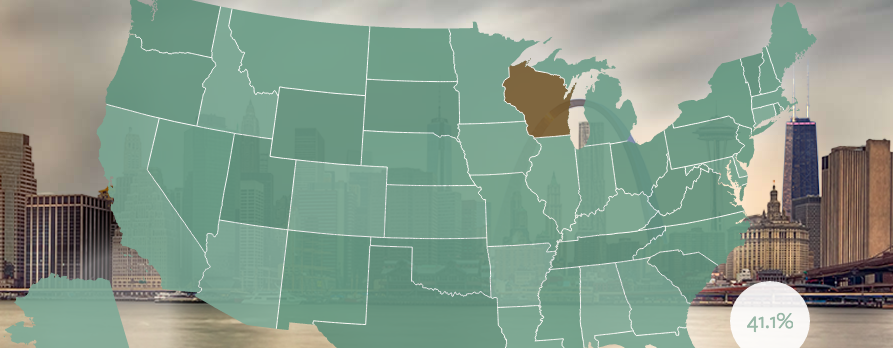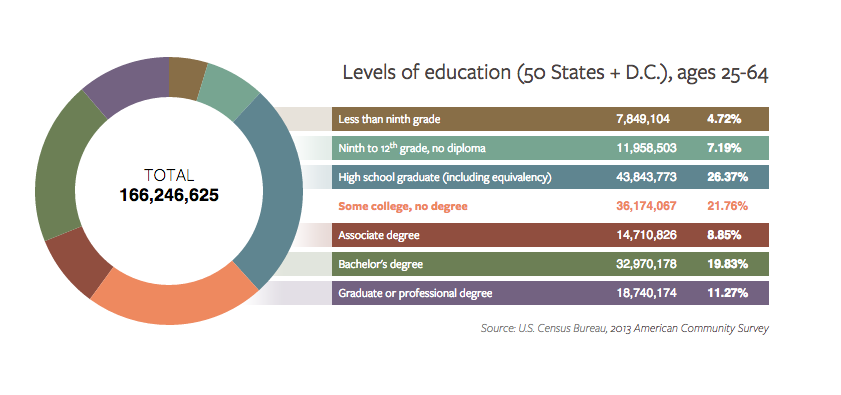By Lisa A. Eramo
Supply and demand. In the business world, this is a fundamental concept and the backbone of a market economy. Ideally, supply increases commensurate with demand, creating a stable equilibrium. In other words, as demand for “widget A” increases, businesses produce more of “widget A” to keep consumers happy. This relationship continues as long as consumers continue to demand and purchase “widget A.”
In the world of education, however, this isn’t always the case. With the rising cost of obtaining a college degree, it shouldn’t come as a surprise that the demand for college-credentialed individuals in the workforce is quickly surpassing the supply. In simplistic terms, employers want college-educated employees, but it seems as though there just aren’t enough of them to go around.
Degree shortage is trending
If current trends continue, the United States will fall short by 19.8 million college credentials by 2025, according to a new report by the Lumina Foundation, which focuses solely on increasing Americans’ success in higher education. The report, A Stronger Nation Through Higher Education, is part of the foundation’s larger initiative, Goal 2025, that seeks to increase adult college attainment by 60 percent over the next ten years.
To achieve Goal 2025, the Lumina Foundation intends to:
- Build a social movement
- Mobilize employers, metro areas, and regions
- Mobilize higher education to increase student success
- Advance state and federal policy
- Create new models of student financial support
- Establish new systems of quality credentials
- Create new models of higher education business and finance
“We have just ten years to reach it, and our current pace of progress is insufficient for meeting employers’ workforce needs and addressing the growing inequality issues we face as a nation,” said Jamie Merisotis, president and CEO of Lumina Foundation, in a Foundation statement. “For America to truly prosper—for the nation to attain, not just individual opportunity and economic security, but social justice and cohesion—an increased sense of urgency is needed to expand college success dramatically, and in all directions.”
Get a UW Flexible Option Degree Guide
Download an introductory guide (PDF) to the self-paced, competency-based UW Flexible Option programs, including details about costs, admission requirements, and more.
Increasing the number of graduates
So what does all of this mean for the average aspiring graduate? In 2025, there will be close to 176 million Americans between the ages of 25 and 64, according to Census Bureau projections. For the nation to reach Goal 2025, 106.4 million of these individuals must hold high-quality postsecondary credentials. The Lumina Foundation defines “high-quality” credentials as those with “clear and transparent learning outcomes leading to further education and employment.” The most important question is this: Will you be part of the statistic that accomplishes Goal 2025? It’s a lofty goal, but one that may be attainable due—in part—to support from the Obama administration that set a similar goal for America to have the highest proportion of college graduates in the world by 2020. The country hasn’t held this title since 1990. Today, the U.S. ranks 12th in the world.
Targeting those with some credit and no degree
Approximately 36 million adults—nearly 22 percent of the working-age population—have some college credit but no formal degree, according to the Lumina report. Are you one of these individuals? If so, what are the barriers? The cost of tuition? In 2013, students graduated with an average of $35,200 in debt, according to a recent report by Fidelity Investments. Student loan debt surpassed credit card debt for the first time in 2010, according to Fastweb.com.
What about time limitations—do family and other responsibilities make it difficult to carve out the time to finish your degree? Or perhaps there are no universities locally that include the program you wish to study?
The good news is that not every degree program requires onsite attendance, costly tuition, and time-consuming courses. For example, a competency-based education (CBE), such as the University of Wisconsin Flexible Option, emphasizes what students know and can do rather than how long they spend studying a particular topic. Unlike traditional programs that require course attendance for a certain duration of time, CBE courses can be completed in a fraction of the time, for example, if the student already possesses the knowledge necessary to demonstrate competency. This is particularly helpful for working adults who may have some college credit but for whom the majority of subject knowledge is gleaned through direct work experience. Competency-based programs allow students to move at their own pace, making education more efficient and cost-effective.
Some have argued that competency-based programs have the power to transform the education industry as we know it. The Center for American Progress, an independent nonpartisan educational institute, dubs CBE a “disruptive innovation” that has the potential to become a “game changer in the delivery and affordability of postsecondary education.” This bodes well for anyone seeking a college degree, including working adults with some college credit but no degree as well as those who simply want to move up in a career, change careers, or increase job security.
Why having a college degree pays off
Today’s workforce increasingly demands individuals who possess a college degree. A college degree is “official recognition of the formal education accumulated in college, which has a dual value: an intrinsic value, enhancing the student’s personality; and a market value, increasing the student’s chances of getting a rewarding job,” writes Panos Mourdoukoutas of Forbes magazine.
Employers want validation of one’s knowledge and mastery of a particular subject area, and having a degree pays accordingly. According to the U.S. Census Bureau, individuals who achieve the following degrees earned these median annual salaries:
- PhD: $100,000 or more
- Master’s: $63,000
- Bachelor’s: $55,700
- Associate: $42,000
- High school diploma: $32,500
Over one’s lifetime, these numbers are significant. On average, those with a bachelor’s degree earn about $2.3 million over their lifetime. Those with advanced degrees, including master’s, doctoral, and professional degrees earn $2.7 million, $3.2 million, and $3.7 million, respectively. Individuals who only finish some college have a lifetime earnings estimate of $1.55 million. Those with a high school diploma earn approximately $1.3 million over their lifetime.
According to CollegeAtlas.org, other benefits of a college degree include the following:
- More job opportunities, including a greater range of lucrative career options
- Greater employer-provided benefits
- Job satisfaction
- Job stability particularly during times of economic downturn
Seize the day, take control of your education
There’s no time like the present to pursue your degree regardless of where and how you do it. Competency-based programs are one of many options and may be ideal for those seeking a cost- and time-effective solution.
Ask yourself this question: What do you want to accomplish in your career? Can a college degree help you?
Do your homework and get the ball rolling. You won’t regret it.
To find out more about the UW Flexible Option and whether this competency-based education option is a good fit for you, call a friendly enrollment adviser today at 1-877-895-3276.


